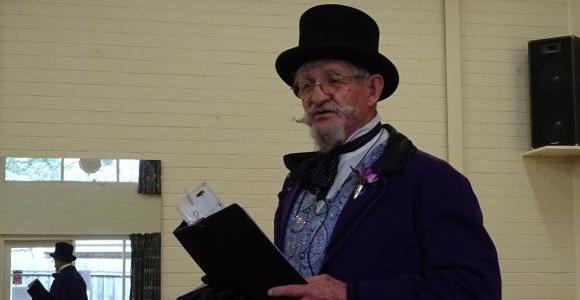
Herb Doctor
You are here

John Harrison
Thursday, 9 July, 2015
The guest speaker was John Harrison, who is widely known as the Herb Doctor, accompanied by his colleague David Leviston. John outlined the history and evolution of herbal medicines, which have always been a part of the apothecary's art. The art, or science, traces back at least 4000 years as humans sought medical assistance. The nature of the profession changed significantly during the 1800s as the medical profession established a formal structure, and the apothecary's practice concentrated more on herbal remedies.
Discussion of medical 'facts' and theories was socially acceptable in Victorian times. All topics seemed to be acceptable, although facts were not always very scientific. For example, it was widely believed that ladies' heads are one-third smaller than men's, so they must be one-third less smart.
The role of the apothecary evolved constantly. Sometimes he was called "the Simpler" -- a herbalist who grew and dispensed herbs as a type of folk medicine. Queen Victoria was a surprisingly progressive monarch, and was the first reigning monarch to use chloroform to ease the pains of childbirth. This gave immediate credibility to that use.
The apothecary's stock included many plant products, each of which had a traditional medical application. Comfrey, as one example, was believed to help healing of broken bones and the growth of teeth. Dropsy, swelling of the limbs due to fluid accumulation, was treated by infusions of plants such as parsley and plantain. He was expected to deal with ailments such as 'nervous excitement' [treated by rosemary and lavender]; diarrhea and dysentery; kidney stones [attributed to excessive alcohol and rich food]; and sarsaparilla as a 'blood purifier'. Aloe vera was sold as a laxative, but over-dosing was a frequent problem.
Customers expected their Simpler to be able to cure whatever troubled them. Accordingly, he needed some diagnostic skills. The stethoscope was part of his kit. It was a listening device, initially a wooden tube which soon took the form of two conical ear-trumpets connected end to end. To treat many mysterious aches and pains, the apothecary explored the use of analgesics, many of which derived from opium. Laudanum is a solution of opium in alcohol and was widely used for almost any ailment - sometimes with fatal results. However it was widely accepted by everyone from Queen Victoria to Sherlock Holmes [or, anyway, Arthur Conan-Doyle].
In addition to these 'medicinal products' the apothecary also sold products which were only loosely related, such as pomades [waxy hair dressings, usually containing mashed apples] pigments to be used in paints. An alternative hair dressing for men was Macassar oil, based on palm oil. Unfortunately it often stained the chair backs, leading to the adoption of daintily-embroidered 'anti-macassars' to protect the furniture.
By today's expectations, the standards of hygiene were very low. Soap was expensive, and hot water was a rare luxury. People therefore relied on herbal extracts and potions as deodorants, and as deterrents for pests. Today, we are all so clean that we have become extremely sensitive to fleas and bedbugs, which would not have been noticed 150 years ago.
Leprosy was quite common, particularly on the goldfields which sprang up wherever a strike was made. Because it was transmitted fairly readily, there were attempts to isolate the sufferers. Victoria's first leprosarium was established by a herbalist, named Jones.
It was a very lively talk, with quite a lot of hilarity involved, complete with John's special outfit.








